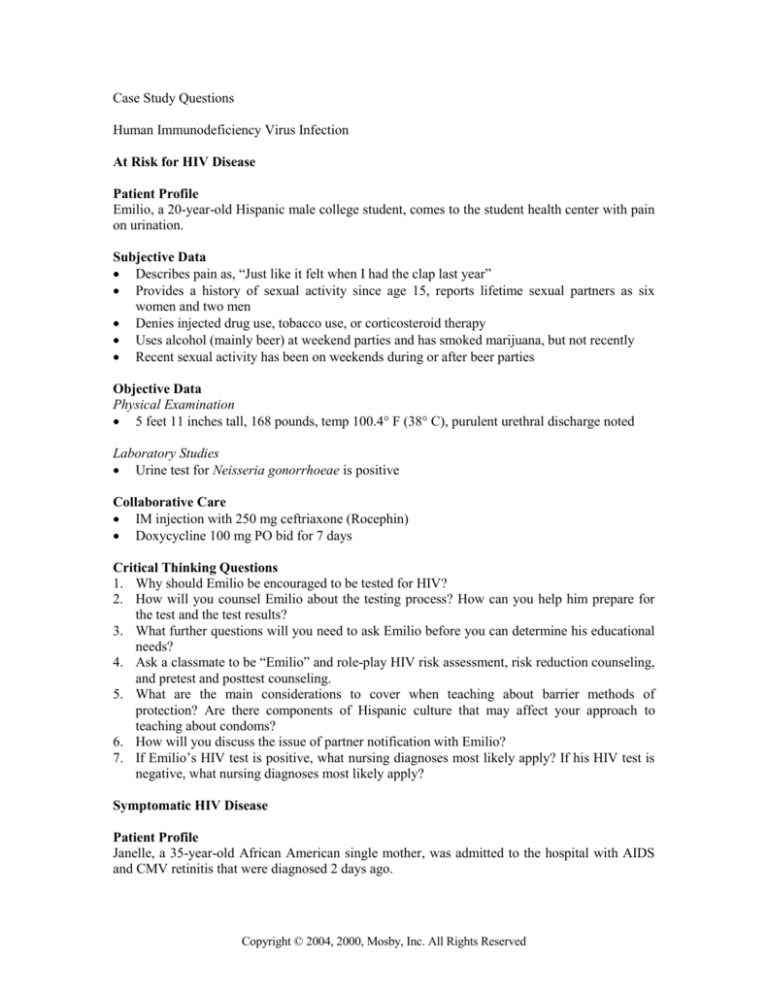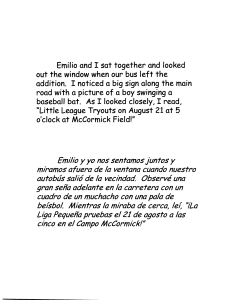
Case Study Questions
Human Immunodeficiency Virus Infection
At Risk for HIV Disease
Patient Profile
Emilio, a 20-year-old Hispanic male college student, comes to the student health center with pain
on urination.
Subjective Data
Describes pain as, “Just like it felt when I had the clap last year”
Provides a history of sexual activity since age 15, reports lifetime sexual partners as six
women and two men
Denies injected drug use, tobacco use, or corticosteroid therapy
Uses alcohol (mainly beer) at weekend parties and has smoked marijuana, but not recently
Recent sexual activity has been on weekends during or after beer parties
Objective Data
Physical Examination
5 feet 11 inches tall, 168 pounds, temp 100.4° F (38° C), purulent urethral discharge noted
Laboratory Studies
Urine test for Neisseria gonorrhoeae is positive
Collaborative Care
IM injection with 250 mg ceftriaxone (Rocephin)
Doxycycline 100 mg PO bid for 7 days
Critical Thinking Questions
1. Why should Emilio be encouraged to be tested for HIV?
2. How will you counsel Emilio about the testing process? How can you help him prepare for
the test and the test results?
3. What further questions will you need to ask Emilio before you can determine his educational
needs?
4. Ask a classmate to be “Emilio” and role-play HIV risk assessment, risk reduction counseling,
and pretest and posttest counseling.
5. What are the main considerations to cover when teaching about barrier methods of
protection? Are there components of Hispanic culture that may affect your approach to
teaching about condoms?
6. How will you discuss the issue of partner notification with Emilio?
7. If Emilio’s HIV test is positive, what nursing diagnoses most likely apply? If his HIV test is
negative, what nursing diagnoses most likely apply?
Symptomatic HIV Disease
Patient Profile
Janelle, a 35-year-old African American single mother, was admitted to the hospital with AIDS
and CMV retinitis that were diagnosed 2 days ago.
Copyright © 2004, 2000, Mosby, Inc. All Rights Reserved
Case Study Questions
2
Subjective Data
Was initially seen by a doctor 6 years ago for pain behind the sternum and difficulty
swallowing, diagnosed as esophageal candidiasis
Had a positive HIV antibody test at that time
Has consistently refused ART because “it’s poison, I’ve seen how sick it makes other people,
and besides, we can’t afford it”
Married to Jim, a former IV drug user, for 10 years until his recent death from AIDS-related
complications
Has two children, ages 8 and 11, who are both HIV-antibody negative
Experiences fatigue and frequent oral and vaginal candidiasis outbreaks
Expresses concern about welfare of children who are at home with her sister and says,
“Maybe I should take better care of myself for them”
Objective Data
Physical Examination
5 feet 6 inches tall, 100 pounds, temperature 99.8° F (37.7° C)
Laboratory Studies
CD4+ T cell count 185/μl
Viral load 25,328 (by bDNA)
Hematocrit 30%
Collaborative Care
Insertion of central venous catheter to be used for CMV treatment
Trimethoprim-sulfamethoxazole
Triple antiretroviral therapy: zidovudine + lamivudine (Combivir) and indinavir (Crixivan)
Critical Thinking Questions
1. Why was Janelle’s initial medical problem (esophageal candidiasis) unusual?
2. Why is Janelle taking trimethoprim-sulfamethoxazole, and what are its common side effects?
3. What drugs are used to treat CMV retinitis? What side effects do they have, and what
problems are associated with their administration?
4. Is there a potential advantage to Janelle’s refusal to take antiretroviral medications in the
past?
5. Women often put their children’s welfare first. What problems could this cause for Janelle’s
treatment? How can these problems be solved?
6. What teaching needs to be done before Janelle is allowed to return home after this
hospitalization? What referrals need to be made? How can Janelle be helped to adhere to her
medication schedule?
7. What psychosocial and legal issues need to be assessed? What interventions might be
appropriate?
8. What nursing interventions are immediately appropriate? What plans need to be made for
continued nursing care after discharge?
9. Based on the assessment data presented, choose at least three appropriate nursing diagnoses.
Are there any collaborative problems?
Copyright © 2004, 2000, Mosby, Inc. All Rights Reserved








